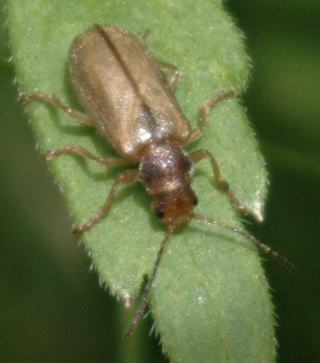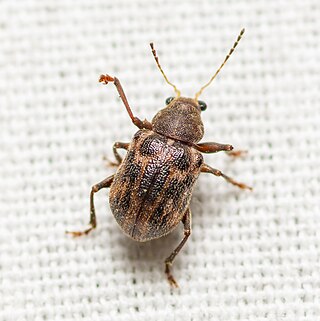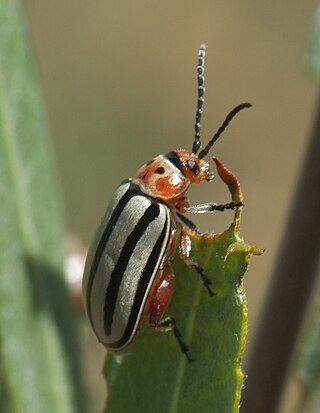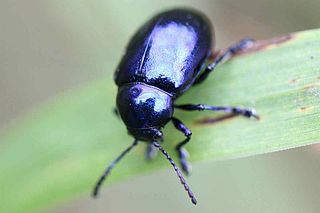
The Synetinae are a small subfamily within the leaf beetle family (Chrysomelidae). They are found entirely within the Holarctic, mainly in North America but also appearing in parts of Europe and Asia. The subfamily contains only two genera, Syneta and Thricolema, with a total of 12 described species. The group is sometimes treated as a tribe of Eumolpinae, where they are known as Synetini.

Altica is a large genus of flea beetles in the subfamily Galerucinae, with about 300 species, distributed nearly worldwide. The genus is best represented in the Neotropical realm, well represented in the Nearctic and Palearctic, but occurs also in the Afrotropic, Indomalaya, and Australasia. The species are similar to each other, small metallic blue-green-bronze beetles, often distinguished from each other only by the aedeagus. The species of Altica, both as larvae and as adults, are phytophagous, feeding on plant foliage of various food plant taxa, specific for each Altica species. Onagraceae and Rosaceae are the dominant host plant families for Holarctic species. The adult Altica beetles are able to jump away when approached.

Xanthonia is a genus of leaf beetles in the subfamily Eumolpinae. It is distributed in North and Central America, and in East, Southeast and South Asia.

Syneta betulae is a species of beetle from the family of leaf beetles, subfamily Synetinae.

Platycorynus is a genus of leaf beetles in the subfamily Eumolpinae. It is distributed in Africa and Asia.

Oreina is a genus of broad-shouldered leaf beetles belonging to the family Chrysomelidae, subfamily Chrysomelinae.

Calligrapha is a genus of large American Chrysomelinae of imprecise taxonomic boundaries. Most species occur in Central and South America.

Disonycha is a genus of flea beetles in the family Chrysomelidae, containing some 170 species in the Nearctic and Neotropics.
Syneta ferruginea, the rusty leaf beetle, is a species of leaf beetle. It is found in eastern North America.

Glyptoscelis is a genus of leaf beetles in the subfamily Eumolpinae. There are 38 species of Glyptoscelis described from North, Central and South America. There are also three species of Glyptoscelis known from the West Indies, though they are wrongly placed in the genus. In addition, a single species was described from Hunan, China in 2021.
Syneta extorris is a species of leaf beetle. It is found in eastern North America.

Scelolyperus is a genus of skeletonizing leaf beetles in the family Chrysomelidae. There are more than 20 described species in Scelolyperus. They are found in North America, Mexico, and the Palaearctic.
Syneta simplex is a species of leaf beetle found in North America. The species includes the two subspecies Syneta simplex simplex, which lives at elevations considerably below timberline and feeds on Garry oak, and Syneta simplex subalpina, which is found near timberline in Washington and British Columbia and feeds on alpine fir.
Phratora hudsonia, the birch leaf beetle, is a species of leaf beetle in the family Chrysomelidae. It is found in North America. This species is known from Canadian populations at the Great Slave Lake and north shore of Lake Superior. It feeds on birch and is metallic brown in color. It is relatively small in size, like other Phratora species.

Coleothorpa dominicana is a species of case-bearing leaf beetle in the family Chrysomelidae. It is found in North America. These case-bearing leaf beetles lay eggs and the female beetle constructs a funnel structure that helps protect the eggs. The larvae lasts for 5 to 8 months and it takes about one year to fully develop the beetles to adulthood.
Monoxia is a genus of skeletonizing leaf beetles in the family Chrysomelidae. There are about 18 described species in Monoxia. They are found in North America and the Neotropics.

Diachus is a genus of case-bearing leaf beetles in the family Chrysomelidae. There are about 10 described species in Diachus.
Syneta pilosa is a species of leaf beetle. It is found in North America.

Chrysochus is a genus of leaf beetles in the subfamily Eumolpinae. It is known from North America, Europe and Asia.

Chrysochus asclepiadeus is a member of the leaf beetle subfamily Eumolpinae. It is considered the type species of the genus Chrysochus, though it has sometimes been placed within the genus Eumolpus. It is the only species of Chrysochus distributed in the western Palaearctic. It is mainly found in Europe, though it is also known from Kazakhstan and Turkey in Asia.














